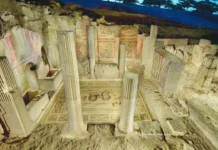An archaeology student made the discovery of a lifetime during her very first excavation in the UK — a rare 1,200-year-old gold artifact dating back to the 9th century.
A Golden Find in Northumberland
Yara Souza, a student from Florida studying at Newcastle University, uncovered the object within just 90 minutes of beginning her excavation in Redesdale, Northumberland.
“I couldn’t believe I found something so quickly on my first dig. It was both exciting and a little overwhelming,” Souza told Daily Mail.
According to Newcastle University, the artifact measures about 4 centimeters long and features a decorative design on one end. It was discovered near the historic Dere Street route, a Roman road that once connected York and Edinburgh.
Historical and Religious Significance
Dere Street remained in use long after the fall of the Roman Empire and today forms part of the modern A68 highway, stretching from Edinburgh to northeast England.
Experts believe the golden piece may have held religious or ceremonial importance, as gold was a material typically reserved for elites of the period. The road itself linked two major religious centers, making its location significant.
James Gerrard, Professor of Roman Archaeology at Newcastle University and Souza’s advisor, said:
“This is an exciting discovery of extraordinary quality. I’m delighted for Yara to have found such an important object at the very beginning of her career.”
He added that the find suggests high-status individuals continued to use the road after the Roman era, and the item may even have been deliberately buried.
A Dream Discovery for a Young Archaeologist
Souza, who is pursuing archaeology at Newcastle, reflected on the experience:
“I had to miss last year’s excavation at Birdoswald Roman fort due to illness. To finally take part this year and uncover something that hasn’t been seen for over a thousand years was unbelievable. I was completely overjoyed.”





[…] Archaeology Student Discovers 1,200-Year-Old Gold Artifact on First Dig […]